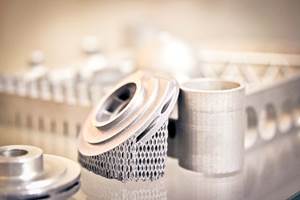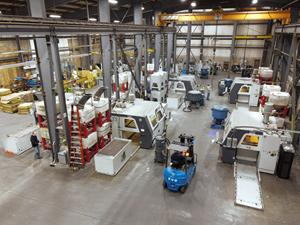Finland Sees Swifter Castings Through Hybrid Manufacturing
Combining sand 3D printing with casting has enabled Hetitec Oy to meet the underserved small-batch Finnish casting market — in some cases, producing high-priority parts in under a week.
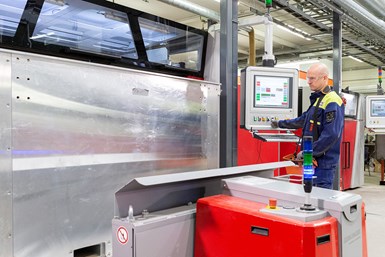
After a process update, the VX2000 can print a full job box of 2 x 1 x 1 m in almost 24 hours. All images courtesy of Hetitec Oy.
Around 2008, Ville Mouilanen, then in charge of Voxeljet’s sales in the Scandinavian market, found the average casting delivery time in Finland was over three months — this, in spite of high demand from Finland’s industrial base in the mechanical engineering, energy supply and shipbuilding sectors. The Finnish foundry industry suffered from a lack of skilled foundry engineers at the time, with serial production through traditional methods keeping the engineers of the time busy.
These conditions inspired Moilanen to start Hetitec Oy, a center for 3D printing of sand molds and cores, in 2013. After several years working with a Voxeljet VX1000 to print furan molds and cores on demand for customers, he decided to scale up in 2018. He would build a foundry around his 3D printing capabilities and specialize in swift castings. This turned into “printed casting” — a hybrid manufacturing approach combining the geometric freedom of 3D printing and the cost benefits of conventional manufacturing.
New Capabilities with Printed Casting
Installation of Hetitec’s first round of casting equipment took place in early 2020. This included four melting furnaces that gave Hetitec the capability to melt steel (including duplex), grey iron, ductile iron (including ADI and SiMo) and aluminum. The foundry also invested in CAD software to avoid casting defects and keep the discharge rate as low as possible.
One more purchase was vital to this evolution: a VX2000 large-format printer from Voxeljet. This system’s build volume of 2 × 1 × 1 m supports the production of large individual molds or a variety of smaller components, depending on the requirements of the build.
“If it were up to our customers, they would prefer to have the castings yesterday,” Moilanen says. While 3D printing can’t go quite that far, a recent process update to the printer that improved its productivity by almost 40% means Hetitec can get close. “We can easily print one job box in less than a single day, which makes the VX2000 the most productive 3D printer in the whole of Finland. Given our equipment, we are able to produce casting sizes ranging from 1 – 600 kg within just a few days with a unique portfolio in terms of material diversity.”
Hetitec has partnered with nearby companies for machining and quality assurance. By doing so, it can proceed through its workflow to deliver finished parts within a week. As Moilanen puts it, “this makes us the fastest freaking foundry in the whole of Scandinavia.”
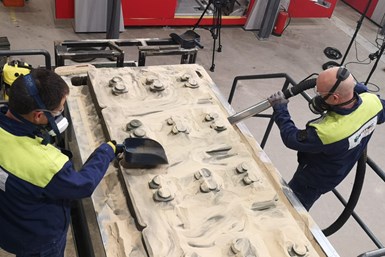
One of Hetitec’s claims to fame is that it constructed its foundry around 3D printing rather than integrating 3D printing into an existing foundry. This emphasis on 3D printing has granted the company the ability to produce and deliver finished castings within a week.
Tools Into Data
“In some cases, only a good 10% of all stored spare part patterns and molds are regularly retrieved and used in Finland,” Moilanen says. “The remaining 90% more or less just take up storage space.”
In addition to casting delivery times, this inventory space issue is one Moilanen hopes to solve with Hetitec’s 3D printing. Using modern scanning technology, the company can transform tool inventories into CAD files, which it can later retrieve from a “digital warehouse” to print and cast as needed. Hetitec hopes its success with this approach will expand the business and lead to further adoption of the process across Scandinavia.
Five Days, Not Five Months
Hetitec points to an example of its repair work for a broken-down icebreaker in Canada as representative of the company’s swiftness and flexibility.
Due to an engine defect, an icebreaker was stuck near the coast of Canada. The usual delivery time for the required component was around five months — a considerable financial problem for the owner. Swift availability of a spare part became the owner’s top priority, and the shipping line turned to Hetitec.
Hetitec was able to turn the 2D design of the spare part into a 3D CAD file within an hour. Production began on a Monday with the 3D printing of sand molds, and by that Friday, the machined and finished casting was on its way to Canada.
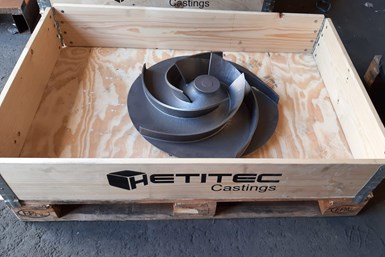
Spare parts and prototypes are specialties of Hetitec. As the Finnish casting industry is mainly focused on series production, small and medium orders are a largely untapped market in the region.
Printing Benefits, Casting Costs
Moilanen is confident about Hetitec’s future in the face of technologies like direct metal laser sintering (DMLS). At the sizes Hetitec often casts, current DMLS processes are prohibitively expensive. The price of sintering powders for aluminum are around €600 per kilogram and the price for certain steel alloys can run up to €1300 per kilogram, while aluminum alloys for casting only cost around €30 per kilogram. Metal casting also provides access to a larger selection of alloys at current, improving its ability to meet a wide range of customer requests.
Related Content
AM 101: What Is Binder Jetting? (Includes Video)
Binder jetting requires no support structures, is accurate and repeatable, and is said to eliminate dimensional distortion problems common in some high-heat 3D technologies. Here is a look at how binder jetting works and its benefits for additive manufacturing.
Read MoreAmerica Makes Announces IMPACT 2.0 Project Call Worth $6.6 Million in Funding
The deadline for the first set of project proposals is May 29.
Read MoreLooking to Secure the Supply Chain for Castings? Don't Overlook 3D Printed Sand Cores and Molds
Concerns about casting lead times and costs have many OEMs looking to 3D print parts directly in metal. But don’t overlook the advantages of 3D printed sand cores and molds applied for conventional metal casting, says Humtown leader.
Read MoreOptimized Castings, Fast Turnarounds with Sand 3D Printing
IMTS 2022: ExOne’s S-Max Flex pairs industrial robots with an end effector printhead design that deposits binder into a 1,900 × 1,000 × 1,000 mm (74 × 39 × 39") telescoping build box that grows as the parts are built layer by layer.
Read MoreRead Next
3D Printing Brings Sustainability, Accessibility to Glass Manufacturing
Australian startup Maple Glass Printing has developed a process for extruding glass into artwork, lab implements and architectural elements. Along the way, the company has also found more efficient ways of recycling this material.
Read MoreTo Improve Performance of Compression Molded Composites, Add 3D Printed Preforms
9T Labs' Additive Fusion Technology enables the manufacture of composite structures with as much or as little reinforcement as is necessary, using 3D printed continuous fiber preforms to add strength just where needed.
Read MoreLooking to Secure the Supply Chain for Castings? Don't Overlook 3D Printed Sand Cores and Molds
Concerns about casting lead times and costs have many OEMs looking to 3D print parts directly in metal. But don’t overlook the advantages of 3D printed sand cores and molds applied for conventional metal casting, says Humtown leader.
Read More








.png;maxWidth=300;quality=90)








